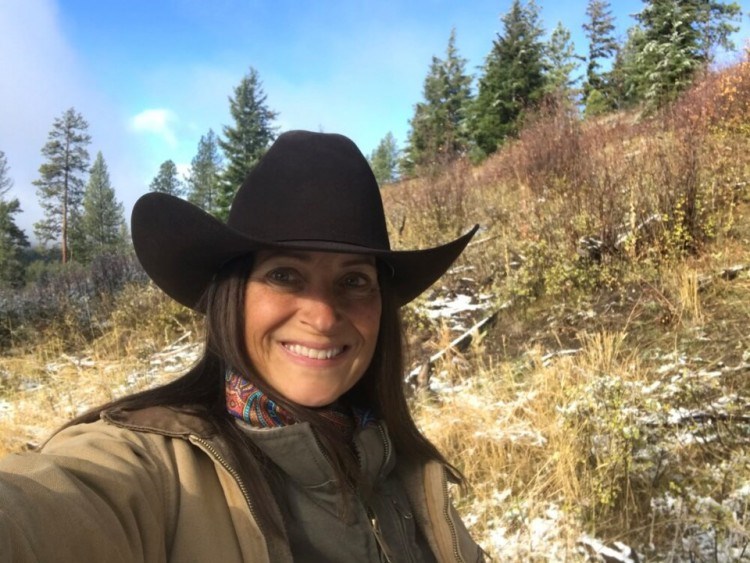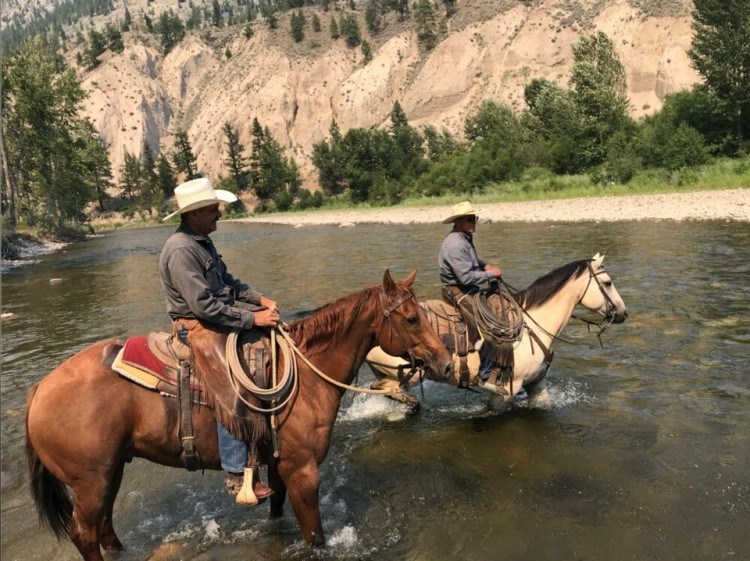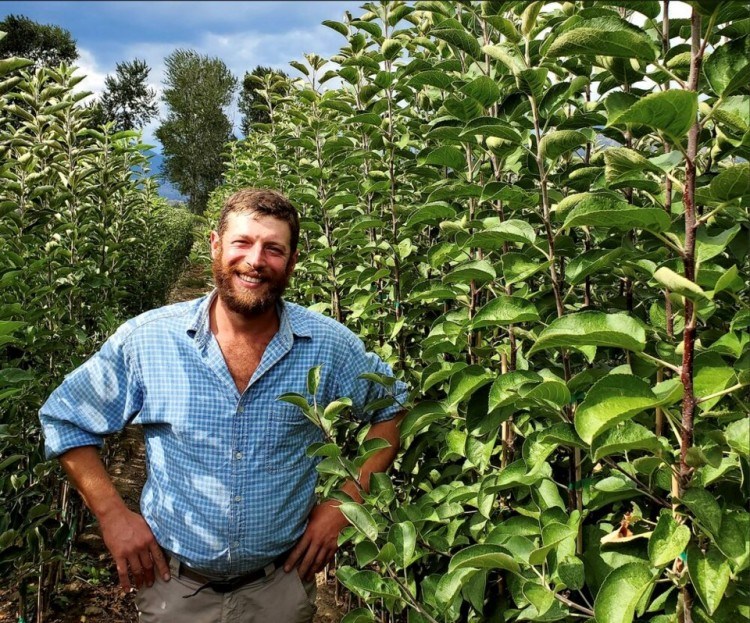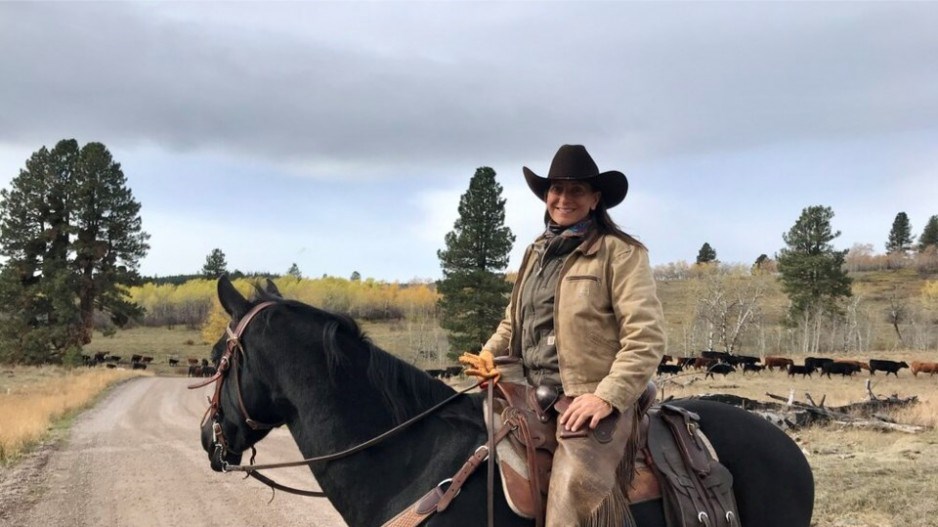High in the rolling foothills southwest of Merritt, B.C., Julia Smith saddles her horse a couple of hours after first light.
By 8 a.m., she rides off her 8.5-hectare, off-grid ranch to meet a half dozen neighbours on horseback and round up cattle. It's a rhythm that has played out uninterrupted for over 100 years in this valley but one that has faced increasing pressure in recent years as wildfire, flooding and heat threaten ranchers’ livelihoods.
Last summer, wildfire tore through the Bar FX Ranch, where Smith winters her cattle.
“The whole thing burned up. It was devastating. They lost 20 per cent of their herd,” Smith said.
Then in November, historic floods rocked the town of Merritt, leading to the evacuation of 7,000 residents. Up the valley at the ranch, the rising water swallowed over six hectares. Like many nearby First Nation reserves, the land is just gone.
“We’ve definitely been on the front lines of the effects of climate change,” Smith said. “As a community, we sure can't deny it.”
In 2021, the toll of extreme weather on B.C.'s farm animals and the food they produce was steep: roughly 1.3 million farm animals cooked to death during the June heat dome or drowned in the November floods.
But where some see only loss, others see an opportunity to do things better. For ranchers like Smith, it’s a chance to build on thousands of years of human ingenuity to lower the industry’s carbon footprint, while building a more secure food supply that can withstand the shocks of climate change.

Months after getting burned in a wildfire, the Bar FX Ranch between Merritt and Spences Bridge lost over six hectares of land to flooding. Julia Smith
From extreme weather to wildfire and drought, climate-driven disasters are increasingly pushing farmers in Canada to seek out new relationships with their land and the food they grow.
That’s especially important as traditional sources of out-of-province fresh food, such as the western United States, face a confluence of drought not seen in 1,200 years and a growing wildfire crisis.
“We’re at the 11th hour,” said Kent Mullinix, director of Kwantlen Polytechnic University’s Institute for Sustainable Food Systems. “We have been so remiss in curtailing GHG (greenhouse gas) emissions, it is inevitable that many of these major food production areas around the world, including California, will face significant collapse.”
“California might not even be able to rely on California.”
A longtime advocate calling on B.C. to create a regional food system, Mullinix says if more small producers grow a bigger variety of food, the province will have a better chance of withstanding the shocks of a pandemic, drought and flooding.
If several dozen farms fail, the reasoning goes, the system holds together. Meanwhile, food is sold directly to local consumers without a middleman taking a cut.
Small producers say that increases the quality of food, gives animals a chance at a dignified life and puts more money in the pockets of ranchers and farmers. Properly supported, it could also lower the costs of food — both for consumers and the future of the planet’s climate system.
But first, small-scale farmers and ranchers need some help.

Friends embrace after the November 2021 flooding took 20% of the livestock at the Bar FX farm, where Julia Smith winters her cattle. Julia Smith
A path to sustainable farming
On Monday, 20,000 farmers released a road map for sustainable farming in Canada, calling for an “ambitious, system-wide approach” to curb carbon emissions and enhance the country’s food security.
At a cost of $2.1 billion, the plan would boost funding to help small-scale producers get their products to market, according to the Farmers for Climate Solutions (FCS) report.
In Canada, farming currently produces an estimated 12 per cent of the country’s total emissions. If carried out, the FCS plan would drop those emissions 14 per cent by 2028.
That means reducing or absorbing 16.2 million tonnes of CO2 from Canada’s annual carbon budget, more carbon than was emitted from the country’s entire petroleum refining industry in 2020.
The report comes as the federal government prepares to negotiate its priorities for the agriculture sector over the next five years. On July 20, multiple levels of government will begin developing a new Agricultural Policy Framework, which will govern spending across Canada until 2028.
As Saskatchewan oil seed producer Cameron Goff put it, governments will be deciding on nothing less than “the future of agriculture” in Canada.
“If we want to have a fighting chance at tackling climate change, we need to get everyone on board to implement these solutions,” he said.
What does that look like? Glacier Media spoke to three small-scale food producers in British Columbia to understand how they are doing things differently.
The rancher
For Smith, it started with hogs.
A decade ago she rented out a scrappy patch of land in the City of Burnaby under the banner “Urban Digs.”
The pasture-raised animals quickly became popular, and Smith realized she needed more space and less rain. So she moved the operation to “this really old-school ranching community” three hours up the Fraser Valley outside Merritt.
That was seven years ago. Today, Smith and her partner usually raise a team of about 60 hogs and 20 heads of cattle at Blue Sky Ranch.
Big ranches rely on volume — raising a large number of animals by letting cattle roam freely across the range and selling calves in the fall for small margins.
Smith, on the other hand, focuses on quality over quantity. To do that, both the animals and ranchers are always moving.
In the winter, Smith sends their cattle down valley where it’s warmer. In the summer, the community of small-scale ranchers drive the cattle between portable fences in an endless cycle that gives the animals access to new patches of grass across the 44,000 hectares of rangeland surrounding the ranch.
That way, the cows don’t overgraze one paddock and destroy the carbon-capturing abilities of the soil. Instead, when a cow takes a bite of grass, its roots slough off, depositing photosynthesized carbon dioxide into the soil in layer after layer of storage.
In just a few years, Smith says the rotational grazing practice transformed her 8.5-hectare property from a relatively unproductive area to a lush pasture. That’s important in an arid, windy region of the province, where without grass, the soil could easily get swept away.
“We couldn't even keep our one dairy cow out there for very long,” Smith said.
On the range, the small-scale ranchers do the same thing, only on a much larger scale.

The range lands near Merritt, B.C., have been home to a ranching community for over 100 years. Julia Smith
What the animals eat matters too. Moving the animals in contained areas allows the rest of the range to recover and develop key legumes like sainfoin, clover and birdsfoot trefoil.
A range planted with one-third of those legumes has proven to drop methane emissions from cow burbs — a powerful source of greenhouse gas — by more than 10 per cent, according to the farmer-led FCS report.
Planting legumes also fixes atmospheric nitrogen into the soil. Together with the cattle manure deposited over the range year-round, the legumes reduce the need for expensive artificial fertilizers known for releasing nitrous oxide emissions — another greenhouse gas.
With inflation and rising fuel costs leading to an increase in the price of almost everything, that’s leading to some unlikely converts, says Smith.
“Even the staunchest climate change denier is suddenly interested in, 'What can I do to reduce my fertilizer needs?'” said Smith.
The benefits of rotational grazing extend beyond the climate. Ranchers who deploy the practice have also found it improves animal health, reduces parasites and increases biodiversity at a time the world is facing steep declines.
It’s all part of a growing regenerative farming movement, which seeks to maximize quality food production while maintaining topsoil, increasing wildlife and improving water quality. In short, says, Smith, “it really is part of the climate change story.”
Transitioning commercial ranches into something more sustainable doesn’t come without barriers. One is finding people willing to work long, hard days.
It takes more people to move modular fencing around than it does to release animals out in a big field, Smith said. Then there's competition with the ongoing construction of the Trans Mountain oil pipeline extension.
“You can just go work on the pipeline for $46 an hour,” said Smith.
The biggest challenge, however, is what Smith describes as the “cut and wrap problem.”
Commercial ranches usually send their animals to feedlots where they spend the last six months of their lives being fed large quantities of grain-rich feed. While the production of that feed is itself driving deforestation in places like the Amazon rainforest, the system also gives big producers preferential access to slaughterhouses, or abattoirs, where animals are killed, bled, cleaned and dressed.
In the first survey of its kind, B.C.’s Small Scale Meat Producers Association — which Smith founded in 2017 — polled 708 operations across the province. The results, released in April, found that many small-scale meat producers were “desperate” to scale up their operations to satisfy demand for high-quality, local meat.
Smith, who puts her meat up for sale directly to consumers on her website, says she usually sells out within six minutes. Still, without scaling up, paying off the bills can be hard for many ranchers.
“We see overwhelmingly people are supporting their ranches with off-farm income,” she said.

Julia Smith moved to a ranch outside of Merritt, B.C., seven years ago after she outgrew her Burnaby hog-raising operation Urban Digs. - Courtesy Julia Smith
A combination of land speculation, rising operating costs and climate-driven natural disasters have all put pressure on ranchers, notes the study.
But a bottleneck on meat processing facilities is the most pressing obstacle to scaling up.
To fix that problem, Smith and her fellow small-scale ranchers in the Nicola Valley have started to build a local co-operative-run abattoir near Merritt. With funding from the B.C. government, it’s expected to be completed by 2024.
Add more local abattoirs, and Canada could see a boom in small-scale ranchers, say advocates, all while taking a cut out of the country's cattle emissions.
“We have huge consumer demand for these products. It's just been a matter of being able to scale our operations to a point where we can meet that demand,” said Smith.
“This is the key to pivoting the cattle industry here to make it more sustainable, both financially and environmentally.”
According to the FCS report, changing the way livestock is managed is the fastest and cheapest way the agricultural sector can reduce greenhouse gas emissions, and could shed over a quarter of the report’s planned emissions reductions at a cost of $7 per tonne.
Part of that funding would help support a Canada-wide grazing management plan and help back infrastructure costs to farmers so they access portable fencing and water.
As Smith put it, “We just need to get over this hump. We have a lot of potential here.”

Julia Smith crosses a river outside of Merritt with her ranching neighbours. - Julia Smith
The nurseryman
Josh Brown’s organic farm is an oasis of fruit trees and fallow fields that lay nestled in Cawston, B.C. — “the coolest little farm town,” as Brown describes it.
“[The town is] still very much centred around farming. It hasn't become overly developed,” Brown said. “There's still tractors driving up and down the road. And when it's harvest time, you can feel it.”
Tucked between the U.S. border and the southern end of Okanagan Lake, Brown’s nearly eight-year-old garden nursery is named after the Similkameen River, which snakes across its western border.
Here, Brown grows an assortment of fruit trees, including apple, plum, nectarine, peach and cherry. The nursery supplies tens of thousands of young trees to backyard gardeners and landscapers across the region, making it the second-largest nursery of its kind in the province, according to Brown.
Brown, who studied environmental geography and economics in Toronto before moving to the Similkameen Valley 15 years ago, said he came into farming with an understanding of environmental issues and has integrated this into his own “1,000-year soil” farming philosophy.
The idea, he says, is simple: continue growing healthy crops year in, year out for the next 1,000 years.
But in his eight years of farming, Brown says that vision can quickly get derailed by unreliable growing conditions made increasingly volatile under a changing climate.
“It's impossible not to notice,” he said, pointing to bigger swings in weather and flood threats.
“[Farmers] don't have the luxury of, in the middle of a torrential downpour, just driving into an underground parking garage and hanging out in an office.”
At Similkameen Nurseries, Brown said he is focused on preserving his “little chunk of land,” its carbon sequestration capabilities and natural biome for years to come.
To do so, he has turned to a practice known as cover cropping.

Josh Brown of Similkameen Nurseries plants 18 cover crops on his Cawston, B.C., land, a practice that helps boost biodiversity and soil health while reducing carbon emissions. Courtesy Josh Brown
Instead of planting for harvest, a cover crop boosts soil fertility and soil health. It’s one of several recommendations put forward in the Farmers for Climate Solutions report.
Farmers have long left fields fallow to regenerate. But planting cover crops takes that practice to the next level, upping the land’s ability to absorb carbon, limit erosion, retain moisture and improve soil structure and biodiversity.
At a cost of $81 per tonne, cover crops could “catch” nitrogen not used in the soil and that would otherwise be released into the atmosphere as nitrous oxide, found the FCS report.
If widely implemented alongside 'intercropping' — planting nitrogen-fixing legumes next to regular crops — the practice could allow Canadian farms to absorb up to 4.3 million tonnes of carbon dioxide every year, says the report.
Like rotational grazing, Brown’s 18 different cover crops — including barley, oats, fava beans, winter peas and radish — provide a variety of spin-off benefits. It also makes the land a nice place to just be, says Brown.
“You walk through our cover crop and it’s the most lush, beautiful… there’s a ton of stuff growing,” he said.
Aside from letting his fields grow wild once in a while, Brown also tries to preserve the streams, ponds and wetlands on his farm.
Such environments are powerful carbon sinks, and can also provide shade and shelter for livestock — not to mention people.
Brown points to a “beautiful big willow tree” growing in the middle of their fields “where we have lunch.”
Despite their proven success, Brown acknowledges planting more cover crops across the country could be a challenge.
“All this stuff costs money,” he said. “It’s a constant expense.”
Some farmers might see fallow land as a waste; seeds for the cover crop species can be expensive, as are irrigation and the labour required to prepare fields.
And in the Canadian Prairies, short growing seasons and low soil moisture levels make it especially difficult to sow cover crops, notes the farmer-led report.
Still, Brown says it’s clear the practice pays off, both for the land and the planet.
Through funding and education, Brown said he hopes the government can help farmers get over the initial expensive hurdles.
“It might be expensive to do it. But I would say that it's far less expensive than other ways that we can reduce greenhouse gas emissions,” he said.
The everything farmer
About 150 kilometres up the Okanagan Valley, Fresh Valley Farms sits in the shadow of Silver Star Mountain.
Just outside the town of Armstrong, B.C., Annelise Grube-Cavers and her partner, Steve, have operated the farm for the past decade.
A fourth-generation farmer, Steve’s family still lives a kilometre down the road on farmland they bought 100 years ago.
Together, Annelise and Steve raise pasture-raised beef, pork, chicken and turkey. The farm also houses a small abattoir where they slaughter their own livestock and was recently approved to cut and wrap its own red meat.
“It’s like farm to table,” Grube-Cavers said. “We sell direct to consumers who purchase from us.”
In recent years, however, she has had to explain to her customers how the changing climate is affecting the health of her livestock. Last summer’s heat dome killed at least 651,000 poultry; for Grube-Cavers, the extreme temperatures stunted her birds’ growth.
“Just like any animal, you're not eating a ton when it's 45 degrees out,” she said. “So that's a pretty dramatic and immediate impact.”
To dampen the effects of extreme heat, Grube-Cavers turned to rotational grazing, just like Smith.
The benefits to the land and its productivity are already evident, says the Armstrong farmer.
“We can look out in our field and see where we rotated turkeys and chickens last year, because you can see… how their manure was spread across the field and the deeper green foliage that’s there,” she said.

Annelise Grube-Cavers on her farm and ranch near Armstrong, B.C. Courtesy Annelise Grube-Cavers
On feedlots, keeping cows inside over the winter leads to big piles of stored manure, itself a source of emissions. On pasture, cow patties and poultry poop act like fertilizer, absorbing into the ground and stimulating further plant and animal growth.
In addition to rotational grazing and growing more cover crops, the farmer-led report found minimizing synthetic nitrogen-based fertilizers could cut 3.8 million tonnes of carbon from Canada’s carbon budget by 2028. That’s equivalent to roughly a third of New Brunswick’s entire emission output in 2020.
Properly treated manure, suggests the report, is a good alternative, and Grube-Cavers is well-positioned to integrate her manure-producing livestock with crops. For example, she knows that covering liquid manure tanks prevents methane emissions. But just like Smith and Brown, cost is limiting the Armstrong farmer from ramping up all the sustainable farming practices open to her.
At the top of her wish list is a No-Till drill.
Designed to plant seeds without eroding the soil, the price of this “essential piece of technology” is holding Grube-Cavers back from implementing even more climate-friendly practices at Fresh Valley Farms, such as cover cropping.
While she awaits the federal government’s decision on what the next five years of funding will look like across Canada’s agricultural sector, Grube-Cavers said she’s relying on other farmers — in farmers institutes or fall fairs — to get the word out about climate-friendly farming solutions.
“The more different farmers start to advocate for those practices… I think the more farmers will pick up on them,” she said.




